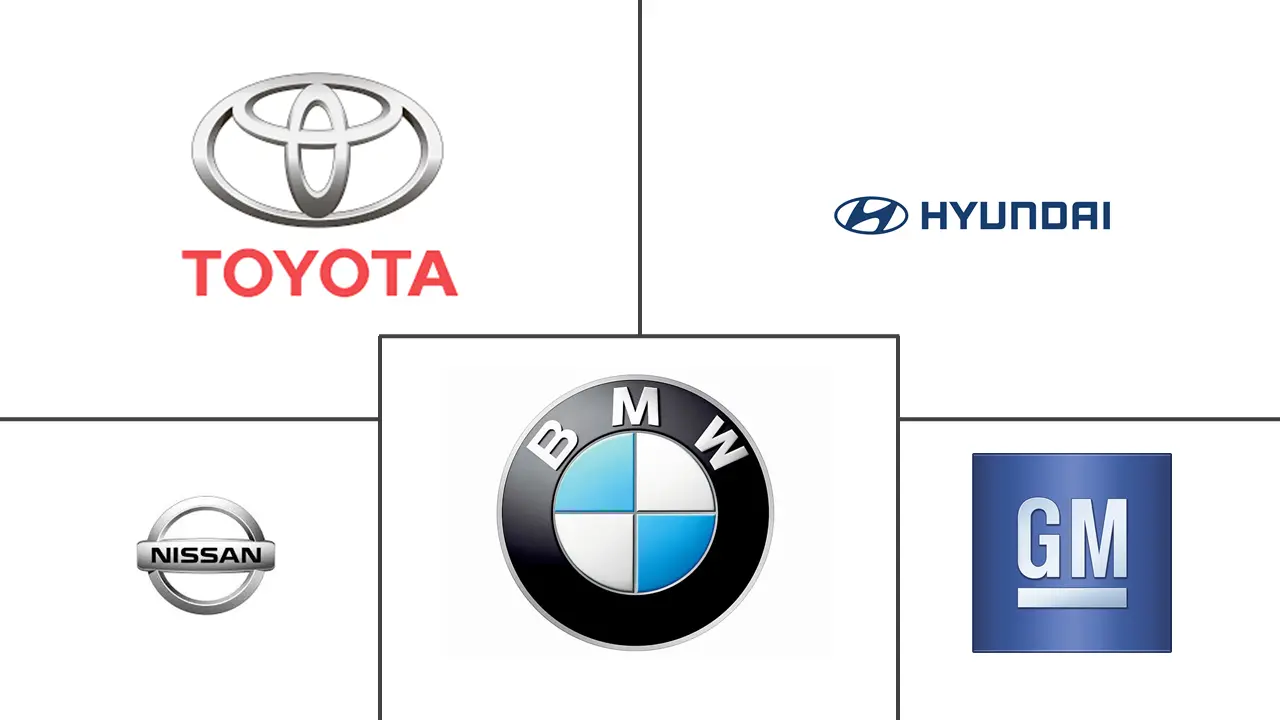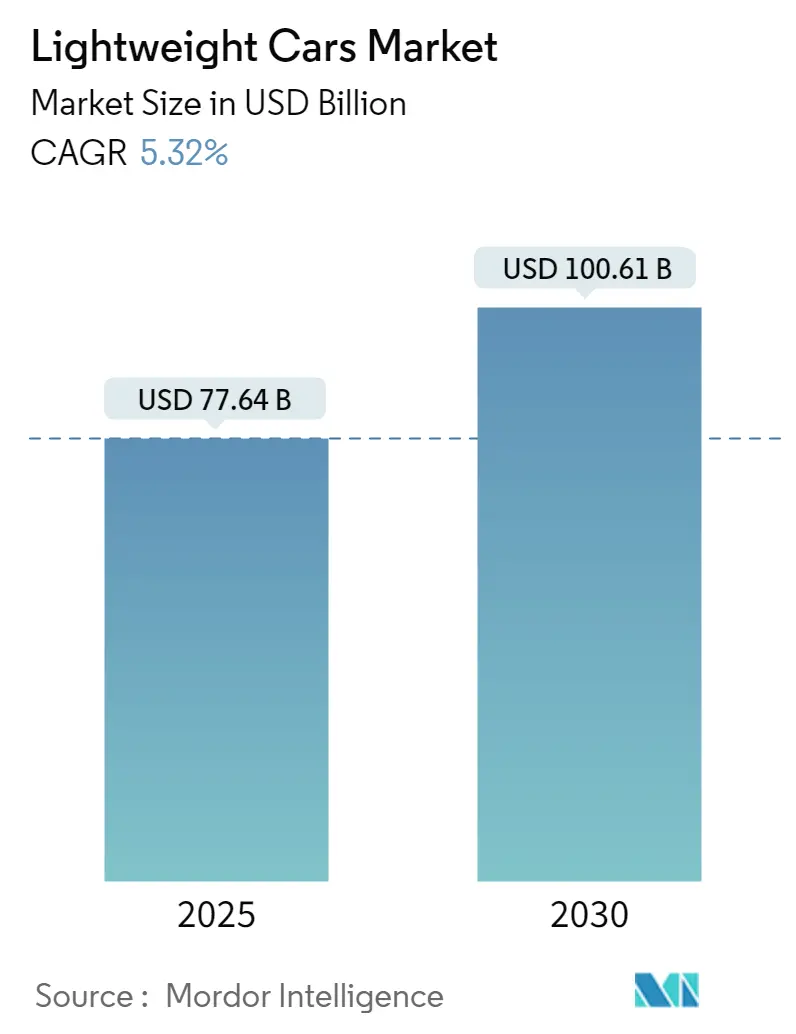
Lightweight Cars Market Analysis by Mordor Intelligence
The Lightweight Cars Market size is estimated at USD 77.64 billion in 2025, and is expected to reach USD 100.61 billion by 2030, at a CAGR of 5.32% during the forecast period (2025-2030).
The lightweight material market represents a significant and evolving segment of the global automotive industry. This market focuses on vehicles designed with materials and technologies that reduce overall weight, leading to improvements in fuel efficiency, performance and environmental impact.
The push for fuel efficiency and emission regulations is a primary driver of the lightweight car market. Governments worldwide are imposing stricter emission standards to combat climate change, incentivizing manufacturers to produce lighter, more fuel-efficient vehicles. This regulatory landscape is intricately connected to performance benefits sought by consumers.
Furthermore, lighter vehicles offer enhanced dynamics like better acceleration and handling, appealing to a segment of the market that values a high-performance driving experience. Additionally, Technological Advancements play a crucial role. Developments in material science and engineering have enabled manufacturers to reduce vehicle weight without compromising on safety or functionality, thus addressing both regulatory and consumer demands.
Regions like North America, Europe and Asia-Pacific are at the forefront of the lightweight car market each influenced by their specific regulatory, economic and consumer landscapes. Europe, for instance, with its stringent emission regulations has been a significant driver of lightweight vehicle technology. These regional markets collectively contribute to a global movement towards lighter more efficient vehicles.
Global Lightweight Cars Market Trends and Insights
Increasing Demand for Lightweight Passenger Cars
The lightweight vehicle market is rapidly evolving primarily driven by the increasing demand for lightweight passenger cars. This segment focuses on reducing vehicle weight through advanced materials and design techniques to enhance fuel efficiency, performance and reduce environmental impact.The shift towards lightweight vehicles is a response to global trends in sustainability, technological advancements and changing consumer preferences.
Furthremore, stricter global emission standards and the rising importance of fuel efficiency are significant drivers of the lightweight vehicle market. Governments worldwide are implementing policies to reduce greenhouse gas emissions leading to a focus on lightweighting as a key strategy.As lightweight vehicles consume less fuel and emit fewer pollutants compared to heavier counterparts making them increasingly attractive in markets with stringent environmental regulations.
The development and adoption of advanced materials such as high-strength steel, aluminum, magnesium and carbon fiber are central to the lightweight car market. These materials offer the necessary strength and durability while significantly reducing vehicle weight.Moreover, technological innovations in manufacturing and design, such as computer-aided engineering and 3D printing, have enabled more precise and efficient use of lightweight materials, further driving market growth.
Also, the rise of electric and hybrid vehicles has been a major catalyst for the lightweight vehicle market. In these vehicles, reducing weight is crucial for maximizing range and efficiency, making lightweight design an essential aspect of electric vehicle (EV) and hybrid technology.This trend has led to increased investment and innovation in lightweight materials and design specifically tailored for electric vehicle and hybrid vehicles.
The market is poised for continued growth and innovation playing a crucial role in the broader shift towards more sustainable and efficient transportation solutions.
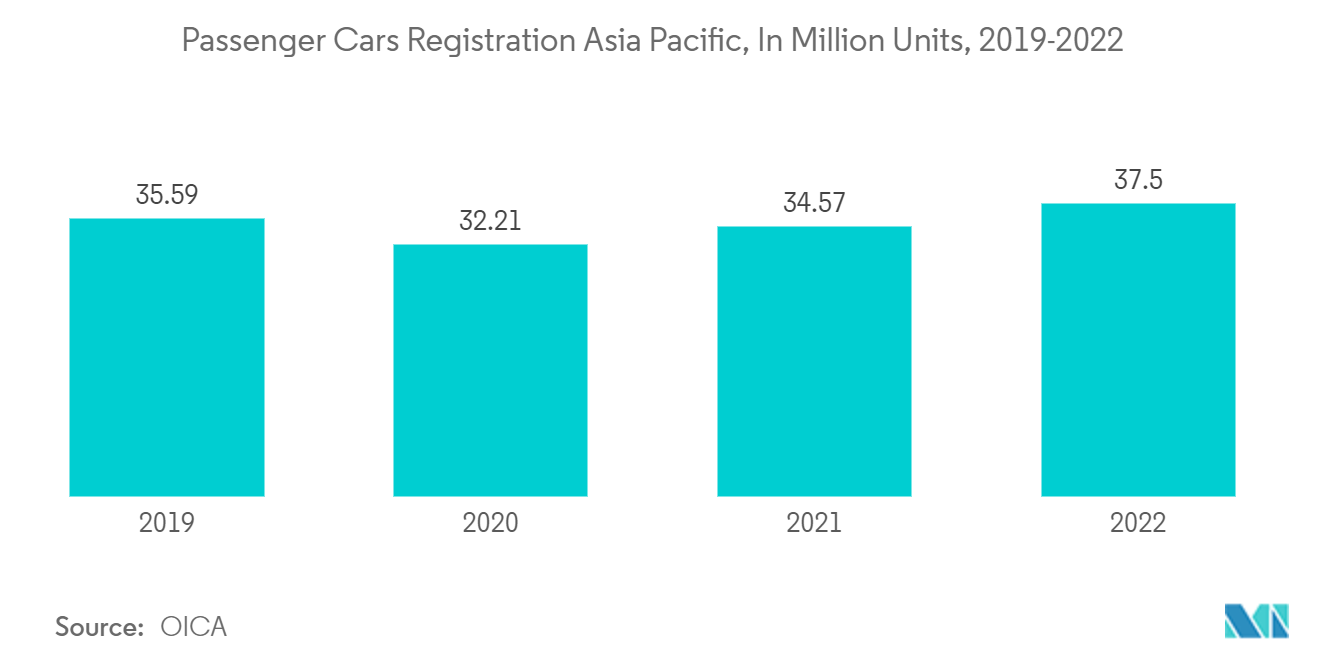
Asia Pacific Region is Dominating the Market
The Asia-Pacific region with its dynamic economies and rapidly evolving automotive sector plays a pivotal role in the global lightweight car market. This region is characterized by its significant automotive production and consumption, driven by countries like China, Japan, India, and South Korea.
The lightweight car segment, focusing on vehicles designed with reduced mass for enhanced fuel efficiency and performance, is seeing substantial growth in this region, influenced by various market forces and technological innovations.
Asia-Pacific's economic landscape is marked by robust growth particularly in emerging economies such as China and India. This growth has led to increased purchasing power and a growing middle class which in turn fuels demand for automobiles, including lightweight vehicles.The region’s economic expansion is not just limited to increased vehicle sales but also encompasses growing investments in automotive research and development, focusing on lightweight materials and technologies.
Moreover, the region is witnessing significant advancements in automotive technologies with a strong focus on developing lightweight materials such as high-strength steel, aluminum, magnesium and carbon fiber.Also, companies in Asia-Pacific are investing in research and development to create innovative lightweight solutions that do not compromise vehicle safety or performance. This includes advancements in manufacturing processes and the integration of lightweight components into vehicle design.
Major automotive players in the Asia-Pacific region such as Toyota, Honda, Hyundai, and Tata Motors are heavily invested in the lightweight car market. These companies are not only developing new models but also collaborating with material suppliers and technology firms to advance lightweight automotive technologies.
These collaborations are essential in driving innovation and reducing the costs associated with lightweight materials and technologies making them more accessible and viable for mass-market vehicles resulting in drive the growth of the market.
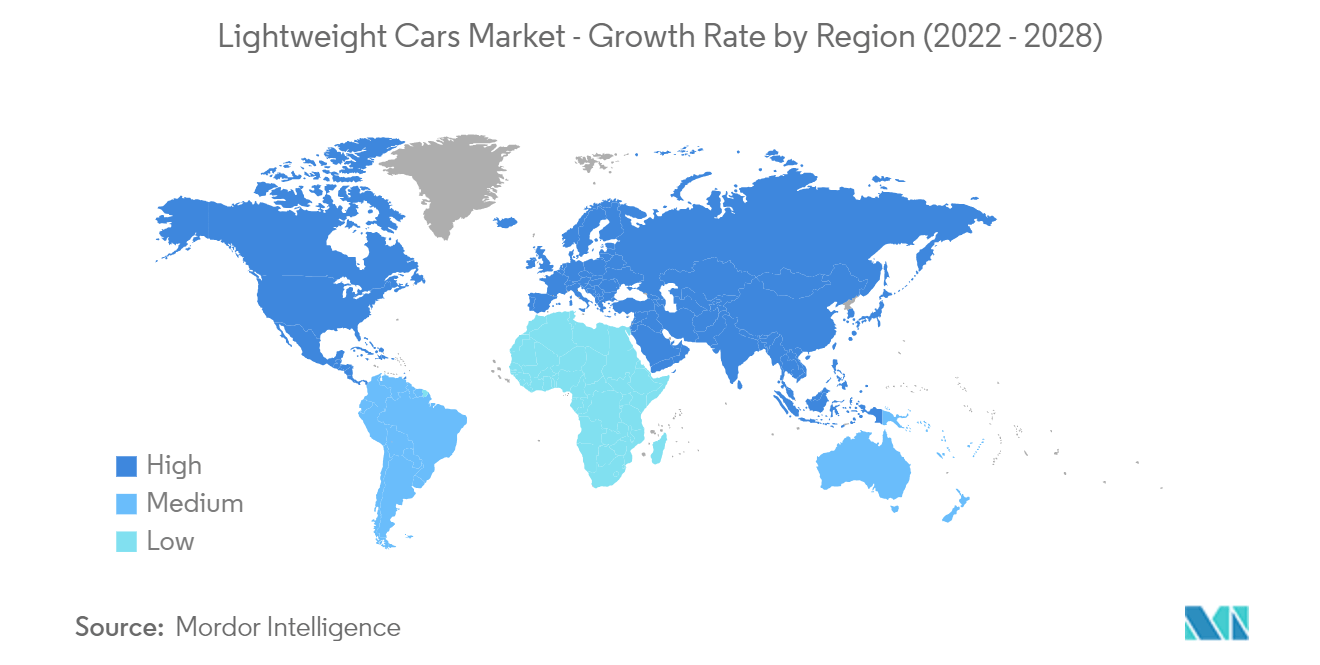
Competitive Landscape
Lightweight Cars Market is consolidated, some of the major players in the lightweight car market are Toyota Motor Corporation, Nissan Motor Co. Ltd, Kia Motors Corporation, Hyundai Motor Co., and Ford Motor Company.
Auto manufacturers majorly dominate the market for lightweight cars. They also have a long-standing partnership with major composite manufacturing companies. With the need for sustainability and lower emissions to protect the environment, many OEMs are releasing electric vehicles on their models. The industry is looking to invest in and develop electric vehicles with the best combination of performance and a long travel range. For instance,
- In December 2023, Toyota Europe has announced plans to roll out a new electric vehicle a Sport Crossover developed in collaboration with BYD. This launch, expected within the next few years is part of Toyota's broader strategy to expand its electric and low-emission vehicle portfolio in Europe by 2026.
- This initiative aligns with the company's commitment to sustainable transportation and marks a significant step in its efforts to introduce a diverse range of environmentally friendly vehicles to the European market. The collaboration with BYD underscores Toyota's approach to leveraging partnerships in advancing its light electric vehicle technology and offerings.
Lightweight Cars Industry Leaders
Toyota Motor Corporation
General Motors
Bayerische Motoren Werke AG (BMW)
Hyundai Motor Co.
Nissan Motor Co. Ltd
- *Disclaimer: Major Players sorted in no particular order
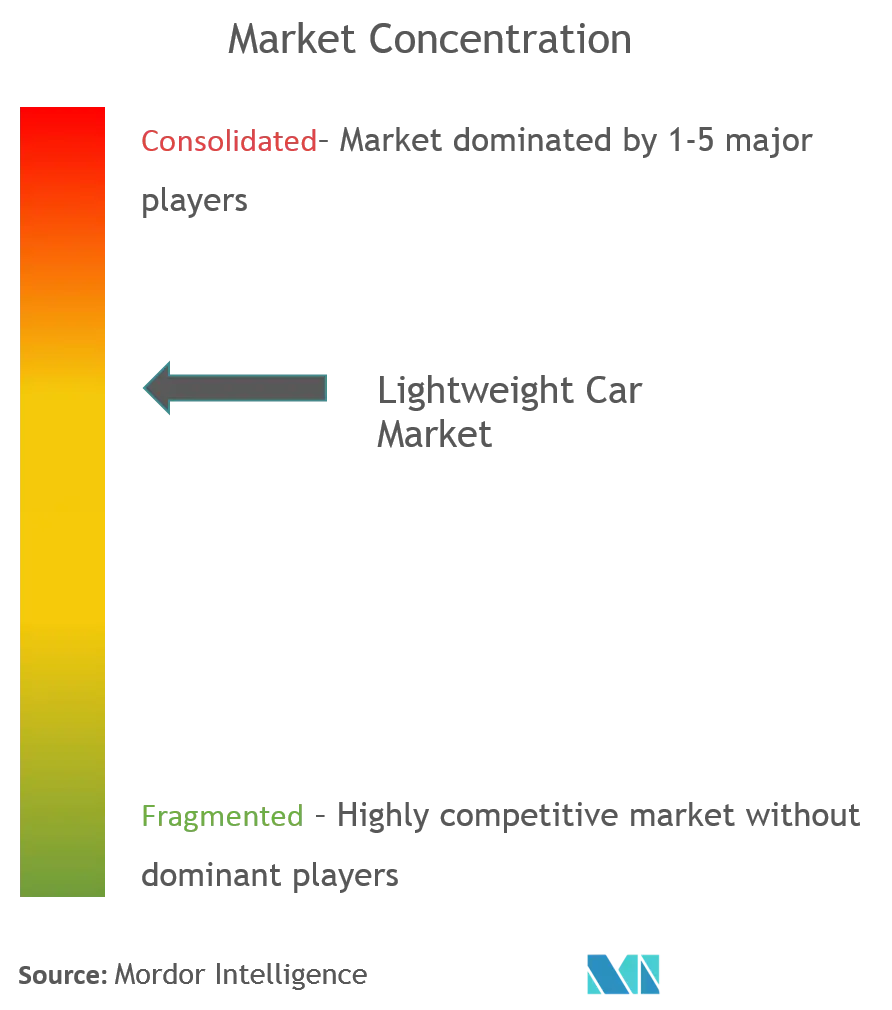
Recent Industry Developments
- In November 2023, Huawei is partnering with Changan Auto, a Chinese car manufacturer to create a new entity for the development of sophisticated automotive systems and components. In this joint venture, Huawei will hold a significant share with Changan Auto's ownership not surpassing 40%.
- The company's primary focus will be on the research, development, manufacturing, sales, and servicing of intelligent automotive systems and solutions for components. This collaboration highlights Huawei's into the automotive industry and emphasizes its commitment to advancing automotive technology.
- In August 2023, A research team led by Clemson University in collaboration with NETL and with support from Honda has developed a lightweight vehicle door using carbon fiber, thermoplastic resin, and advanced computer design.
- This door is 32% lighter than a conventional steel door and successfully meets federal safety standards and Honda's specific safety requirements. This innovation is significant for the automotive industry as it offers a way to create safer, lighter vehicles that are more fuel-efficient and produce fewer emissions, without compromising on performance.
- In June 2023, ZF has unveiled EVbeat an electric concept vehicle emphasizing utmost compactness, minimal weight and optimized efficiency in actual use. In this electric vehicle by ZF, the elements of an electric drivetrain are finely tuned and integrated into a cohesive system.
- Additonally this includes an ultra-lightweight, highly compact driveline weighing just 74 kg boasting an impressive torque density of 70 N·m/kg. This concept represents ZF's commitment to enhancing the efficiency and performance of electric vehicles through advanced system integration and lightweight design.
- In May 2022, Mercedes-AMG unveiled its Vision AMG all-electric concept car. The four-door coupé is built on the AMG. A platform is being developed in Affalterbach for all-electric performance models. The Vision AMG's innovative Axial Flux Motor was developed by Mercedes-Benz's wholly owned subsidiary YASA. Its compact and lightweight design provides significantly more power than conventional electric motors.
Global Lightweight Cars Market Report Scope
A lightweight car is defined as a vehicle that is specifically designed and constructed using materials and techniques that reduce its overall weight. The primary objective of making cars lighter is to enhance their fuel efficiency, performance and reduce their environmental impact.
The lightweight car market is segmented by car type, material type, and geography.By car type, the market is segmented into passenger cars and sports cars. By material type the market is segmented into glass fiber, carbon fiber, high-strength steel, and other material types.By Geography, the market is segmented into North America, Europe, Asia-Pacific, South America, and Middle-East and Africa.
The report offers market sizes and forecasts for the lightweight car market in value (USD) for all the mentioned segments.
| Passenger Cars |
| Sports Cars |
| Glass Fiber |
| Carbon Fiber |
| High-strength Steel |
| Other Material Types |
| North America | United States |
| Canada | |
| Rest of North America | |
| Europe | Germany |
| United Kingdom | |
| France | |
| Rest of Europe | |
| Asia-Pacific | China |
| Japan | |
| India | |
| South Korea | |
| Rest of Asia-Pacific | |
| South America | Brazil |
| Rest of South America | |
| Middle-East and Africa | United Arab Emirates |
| South Africa | |
| Rest of Middle-East and Africa |
| Car Type | Passenger Cars | |
| Sports Cars | ||
| Material Type | Glass Fiber | |
| Carbon Fiber | ||
| High-strength Steel | ||
| Other Material Types | ||
| Geography | North America | United States |
| Canada | ||
| Rest of North America | ||
| Europe | Germany | |
| United Kingdom | ||
| France | ||
| Rest of Europe | ||
| Asia-Pacific | China | |
| Japan | ||
| India | ||
| South Korea | ||
| Rest of Asia-Pacific | ||
| South America | Brazil | |
| Rest of South America | ||
| Middle-East and Africa | United Arab Emirates | |
| South Africa | ||
| Rest of Middle-East and Africa | ||
Key Questions Answered in the Report
How big is the Lightweight Cars Market?
The Lightweight Cars Market size is expected to reach USD 77.64 billion in 2025 and grow at a CAGR of 5.32% to reach USD 100.61 billion by 2030.
What is the current Lightweight Cars Market size?
In 2025, the Lightweight Cars Market size is expected to reach USD 77.64 billion.
Who are the key players in Lightweight Cars Market?
Toyota Motor Corporation, General Motors, Bayerische Motoren Werke AG (BMW), Hyundai Motor Co. and Nissan Motor Co. Ltd are the major companies operating in the Lightweight Cars Market.
Which is the fastest growing region in Lightweight Cars Market?
Asia-Pacific is estimated to grow at the highest CAGR over the forecast period (2025-2030).
Which region has the biggest share in Lightweight Cars Market?
In 2025, the Asia-Pacific accounts for the largest market share in Lightweight Cars Market.
What years does this Lightweight Cars Market cover, and what was the market size in 2024?
In 2024, the Lightweight Cars Market size was estimated at USD 73.51 billion. The report covers the Lightweight Cars Market historical market size for years: 2019, 2020, 2021, 2022, 2023 and 2024. The report also forecasts the Lightweight Cars Market size for years: 2025, 2026, 2027, 2028, 2029 and 2030.
Page last updated on:
Lightweight Cars Market Report
Statistics for the 2025 Lightweight Cars market share, size and revenue growth rate, created by Mordor Intelligence™ Industry Reports. Lightweight Cars analysis includes a market forecast outlook for 2025 to 2030 and historical overview. Get a sample of this industry analysis as a free report PDF download.
